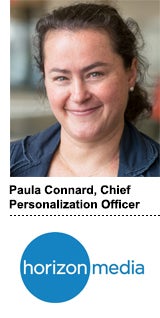Four years ago, independent media agency Horizon Media took stock of the work it was doing for clients and realized there was a big overreliance on third-party data and third-party technology assets.
“We were using a lot of DMPs and CDPs on behalf of our clients and noticed that there were a lot of gaps and limitations in this tech in terms of how you could use the data and in the granularity of the data,” said Paula Connard, chief personalization officer at Horizon Media.
For instance, she said, “you couldn’t really use the audiences outside of digital properties and channels.”
The provenance of third-party data also is unclear, she said, and it’s often hard to know if the data’s been modeled or when it was last refreshed.
“Frankly, it was kind of expensive and not really working,” Connard said.
Horizon followed up its review with the launch of a homegrown data platform called blu., which uses PII data licensed directly from TransUnion to serve as its identity layer (or “spine” in agency parlance). From that database, blu. pulls in deterministic consumer profile data from more than 283 million individuals in the US, including name, phone number, physical address and email.
Clients can enhance these profiles with their own known consumer attributes, such as employment status, demographics, home ownership and income, and do lookalike or propensity modeling.
“DMPs and DSPs felt like black boxes,” Connard said. “We want to position clients to help them do more with their data and give them the control to take certain things in house.”
Connard spoke with AdExchanger.
AdExchanger: What does a chief personalization officer do? It’s not a title I’ve come across before.
PAULA CONNARD: There are so many different ways to apply data assets, and media is just a part of what we do. It’s really about creating personalized experiences across screens, whether that’s with advertising, on a website or even in an offline situation like at an event. That’s what I do.
Clients are typically so siloed between media, CRM, email, creative and their website. But we have data technology that can tie those things together to do real customer journey orchestration.
Why did Horizon decide to build a data platform rather than buy one?
As an independent agency, we still have one P&L that’s controlled by our CEO, Bill Koenigsberg, and I work with him directly on our investment plan. We’re able to change, evolve and build faster because of that. We have flexibility that our competitors, many of the large holding companies, don’t have.
How does blu. differentiate from other agency data platforms, of which there are many?
Well, we don’t use third-party cookies. We built knowing that there would be changes coming. We also license our data directly. We call it going straight to the farm. It comes to us and goes right into AWS at the most granular level. Then we get it ready for querying and put it into Snowflake.
I have a team of marketing scientists, and we build custom models for our clients. Once the data is in our UI, we can do cluster analysis, we can use advanced statistical techniques, we can do Boolean logic audience building, and the data is refreshed daily. That’s not something you can do if you’re using prepackaged third-party data and templatized approaches.
What sort of custom models have you created for clients?
Recently, a lot of our clients have become interested in understanding underserved audiences, like Hispanic audiences, for example. We scored our entire database using machine learning techniques to figure out which IDs had the propensity to be Hispanic and then we brought in a retail client’s loyalty data and looked at the file against our spine to see what lifetime value actually looked like for that audience.
What sort of questions are you getting from clients about dealing with signal loss?
One of the first things they want to understand is the implications of third-party cookie changes and how that is going to impact their data sources. They want to understand the impact on things like remarketing and attribution and also the tweaks they’ll need to make in terms of the marketing or tech stacks they’re using.
It’s a lot of education because it’s not like everyone lives and breathes this all day.
What do you think of the work that’s happening in the Chrome Privacy Sandbox and are you involved with any of the API testing or do you plan to be?
We’re a little bit involved in it, but it feels like there’s a lot of talk and not a lot of action. It’s like a cart-before-the-horse situation. We always have to test everything, but right now it’s a lot of wait and see.
There are always going to be a lot of starts and stops, like with FLoC. It’s important work, but it takes a lot of effort and time, so it feels slow and iterative. It’s yet another big thing to do, and you’d almost have to create another team just to deal with it.
This interview has been edited and condensed.















